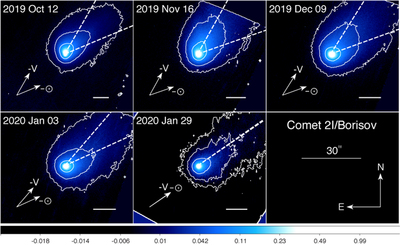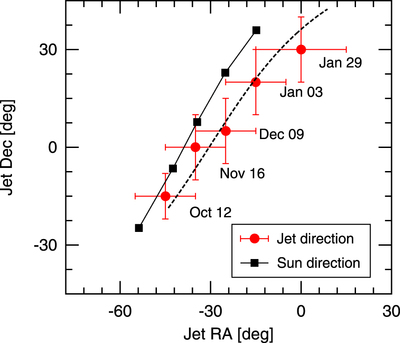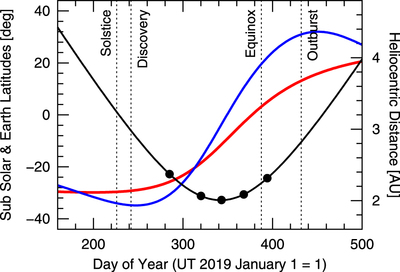- 1Max Planck Institute for Solar System Research, Göttingen, Germany (kimy@mps.mpg.de)
- 2Department of Earth, Planetary and Space Sciences, UCLA, USA
- 3Department of Physics and Astronomy, UCLA, USA
- 4Institute for Geophysics and Extraterrestrial Physics, TU Braunschweig, Germany
- 5Space Telescope Science Institute, Baltimore, USA
- 6Institute for Astronomy, University of Hawaii, USA
- 7Johns Hopkins University Applied Physics Laboratory, Laurel, USA
We present Hubble Space Telescope observations of interstellar comet 2I/Borisov on five occasions between UT 2019 October 12 and 2020 January 29. Our high-resolution images show persistent asymmetry in the dust coma (Figure 1), best explained by a thermal lag on the rotating nucleus, with peak mass loss occurring in the comet nucleus afternoon (Figure 2). In this interpretation, the nucleus rotates with an obliquity of 30 deg (pole direction R.A. = 205 deg and decl. = 52 deg). The subsolar latitude varied from -35 deg (southern solstice) at the time of discovery to 0 deg (equinox) in 2020 January, suggesting that long-term variations in the coma brightness and activity level may be influenced by seasonal effects (Figure 3). Our model shows that newly reported photometric outbursts (Drahus et al. 2020) and the release of a fragment (Jewitt et al. 2020) could result from a seasonal effect, as the northern hemisphere is illuminated for the first time.
Reference: Kim, Y., et al. 2020, ApJL, 895, L34.

Figure 1: HST images of 2I/Borisov marked with UT dates of observation. Isophotal contours and extended antisolar and negative velocity vectors (dashed lines) are overlaid to highlight an asymmetry in the coma.

Figure 2: Best-fit solutions for the model jet direction (red circles and dashed line), showing a systematic drift with time from 2019 October to 2020 January. The solutions follow the changing projected direction of the Sun (black squares and solid line), but are offset from it by ~20 deg. The existence of this offset suggests a thermal lag on the rotating nucleus.

Figure 3: Subsolar (red) and sub-Earth (blue) latitude of 2I/Borisov as a function of time, together with the heliocentric distance (black solid line) on the right axis. We assumed a rotation pole orientation of R.A. = 205 deg and decl. = 52 deg.
How to cite: Kim, Y., Jewitt, D., Agarwal, J., Mutchler, M., Hui, M.-T., and Weaver, H.: Coma Anisotropy and the Rotation Pole of Interstellar Comet 2I/Borisov, Europlanet Science Congress 2020, online, 21 Sep–9 Oct 2020, EPSC2020-955, https://doi.org/10.5194/epsc2020-955, 2020.

